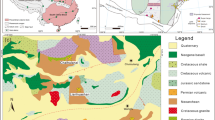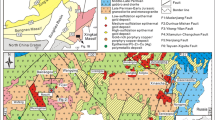Abstract
The Xiling Sn deposit in eastern Guangdong Province comprises the Fengdishan Sn and the Saozhoudi Sn–Pb–Zn ore blocks and has long been regarded as a volcanic–subvolcanic system related to Sn polymetallic mineralization. Here, we present fluid inclusion microthermometric data from different ore stages and H–O–S isotope data of hydrothermal minerals to constrain the genesis of the Xiling deposit. Fluid inclusions from stage I have Th values from ~ 340 to 420 °C and salinities from ~ 15 to 17 wt% NaCl equivalent, while homogenization temperatures of fluid inclusions from stages II to V range from ~ 150 to 320 °C, and salinities range between ~ 1 and 6 wt% equivalent. The oxygen and hydrogen isotopic composition of quartz and cassiterite (δDfluid − 65‰; δ18Ofluid 3.6 to 6.3‰) suggest that the ore-forming fluids from stage I have a distinct magmatic signature, whereas those from stage II through stage IV (δDfluid from − 80 to − 49‰; δ18Ofluid from − 3.7 to 2.5‰) show characteristics of mixing between meteoric and magmatic fluids. Moreover, δ34S values for sulfides from the Fengdishan ore block have a narrow range of 0.6 to 2.5‰ with a mean close to 0‰, consistent with a magmatic sulfur source. By contrast, δ34S values for ore minerals from the Saozhoudi ore block range from 3.4 to 11.5‰, suggesting involvement of a sedimentary sulfur source. In addition, a previous geochronological study has shown that the volcanic–subvolcanic host rocks have an age of 160–170 Ma, while the Sn polymetallic mineralization has an age of about 145 Ma. Our data support a model of mixing of magmatic brine from a hidden granitic intrusion with meteoric water. The S isotope data and the observed temperature gradient of the fluid system suggest that the Sn mineralization is developed in the central part of the ore system, while the Sn–Pb–Zn and Pb–Zn mineralization occurs in the distal part. This finding might have important implications for exploration in the region.











Similar content being viewed by others
References
Audétat A, Günther D, Heinrich CA (1998) Formation of a magmatic hydrothermal ore deposit: insights with LA–ICP–MS analysis of fluid inclusion. Science 279:2091–2094
Charvet J, Shu LS, Shi YS, Guo LZ, Faure M (1996) The building of South China: collision of Yangzi and Cathaysia blocks, problems and tentative answers. J Asian Earth Sci 13:223–235
Chaussidon M, Lorand JP (1990) Sulphur isotope composition of orogenic spinel lherzolite massifs from Ariège (North–Eastern Pyrenees, France): an ion microprobe study. Geochim Cosmochim Acta 54:2835–2846
Chen L, Chen KY, Bao ZA, Liang P, Sun TT, Yuan HL (2017) Preparation of standards for in situ sulfur isotope measurement in sulfides using femtosecond laser ablation MC–ICP–MS. J Anal At Spectrom 32:107–116
Chen XH, Hu XZ, Cong XD (1986) Genesis and mineralization of subgranitic porphyry, Xiling tin deposit, Guangdong. Geochimica 1:50–57 (in Chinese with English abstract)
Christiansen EH, Burt DM, Sheridan MF, Wilson RT (1983) The petrogenesis of topaz rhyolites from the western United States. Contrib Mineral Petrol 83:16–30
Clayton RN, Mayeda TL (1963) The use of bromine pentafluoride in the extraction of oxygen from oxides and silicates for isotopic analysis. Geochim Cosmochim Acta 27:43–52
Coleman ML, Sheppard TJ, Durham JJ, Rouse JE, Moore GR (1982) Reduction of water with zinc for hydrogen isotope analysis. Anal Chemi 54:993–995
Cunningham CC, McNamee J, Vásquez JP, Erichsen GE (1991) A model of volcanic dome-hosted precious metal deposit in Bolivia. Econ Geol 86:415–421
Drummond SE, Ohmoto H (1985) Chemical evolution and mineral deposition in boiling hydrothermal systems. Econ Geol 80:126–147
Eugster HP (1986) Minerals in hot water. Am Mineral 71:655–673
Fekete S, Weis P, Thomas P, Driesner T, Bouvier AS, Baumgartner L, Heinrich C (2017) Contrasting hydrological processes of meteoric water incursion during magmatic–hydrothermal ore deposition: an oxygen isotope study by ion microprobe. Earth Planet Sci Lett 451:263–271
Gilder S, Courtillot V (1997) Timing of the North–South China collision from new middle to late Mesozoic paleomagnetic data from the North China Blocks. J Geophys Res 102:713–727
Goldstein RH, Reynolds TJ (1994) Systematics of fluid inclusions in diagenetic minerals: Society of Sedimentary Geology. SEPM Short Course 31:1–199
Heinrich CA (1990) The chemistry of hydrothermal tin (tungsten) ore deposition. Econ Geol 85:457–481
Hoefs J (2009) Stable isotope geochemistry, 6th edn. Springer Verlag Berlin, Heidelberg
Hu RZ, Wei WF, Bi XW, Peng JT, Qi YQ, Wu LY, Chen YW (2012) Molybdenite Re–Os and muscovite 40Ar/39Ar dating of the Xihuashan tungsten deposit, central Nanling district, South China. Lithos 150:111–118
Huang B, Qi JZ (1991) A special type of tin deposit, east Guangdong. Bull Nanjing Inst Geol MR Chinese Acad Geol Sci 12:67–75 (in Chinese with English abstract)
Korges M, Weis P, Lüders V, Laurent O (2017) Depressurization and boiling of a single magmatic fluid as a mechanism for tin–tungsten deposit formation. Geology 46:75–78
Lehmann B (1990) Metallogeny of tin. Springer, Berlin
Liu P, Mao JW, Cheng YB, Yao W, Wang XY, Hao D (2017) An Early Cretaceous W–Sn deposit and its implications in southeast coastal metallogenic belt: constraints from U–Pb, Re–Os, Ar–Ar geochronology at the Feie’ shan W–Sn deposit, SE China. Ore Geol Rev 81:112–122
Liu P, Mao JW, Pirajno F, Jia LH, Zhang F, Li Y (2018a) Ore genesis and geodynamic setting of the Lianhuashan porphyry tungsten deposit, eastern Guangdong Province, SE China: constraints from muscovite 40Ar–39Ar and zircon U–Pb dating and Hf isotopes. Mineral Deposita 53:797–814
Liu P, Mao JW, Santosh M, Xu LG, Zhang RQ, Jia LH (2018b) The Xiling Sn deposit, eastern Guangdong Province, Southeast China: a new genetic model from 40Ar/39Ar muscovite and U–Pb cassiterite and zircon geochronology. Econ Geol 113:511–530
Liu P, Mao JW, Santosh M, Bao ZA, Zeng XJ, Jia LH (2018c) Geochronology and petrogenesis of the Early Cretaceous A–type granite from the Feie’shan W–Sn deposit in the eastern Guangdong Province, SE China: implications for W–Sn mineralization and geodynamic setting. Lithos 300–301:330–347
Mao JW, Xie GQ, Guo CL (2007) Large–scale tungsten mineralization in the Nanling region, South China: metallogenic ages and corresponding geodynamic processes. Acta Petrol Sin 23:2329–2338 (in Chinese with English abstract)
Mao JW, Cheng YB, Chen MH, Pirajno F (2013) Major types and time–space distribution of Mesozoic ore deposits in South China and their geodynamic settings. Mineral Deposita 48:267–294
Ohmoto H (1972) Systematics of sulfur and carbon isotopes in hydrothermal ore deposits. Econ Geol 67:551–578
Ohmoto H, Rye RO (1979) Isotopes of sulfur and carbon. In: Barnes HL (ed) Geochemistry of hydrothermal ore deposits, 2nd edn. John Wily and Sons, New York, pp 509–567
Polya DA (1989) Chemistry of the main–stage ore–forming fluids of the Panasqueira W–Cu (Ag)–Sn deposit, Portugal: implications for models of ore genesis. Econ Geol 84:1134–1152
Qi HW, Hu RZ, Wang XF, Qu WJ, Bi XW, Peng JT (2012) Molybdenite Re–Os and muscovite 40Ar–39Ar dating of quartz vein–type W–Sn polymetallic deposits in Northern Guangdong, South China. Mineral Deposita 47:607–622
Qiu ZW, Yan QH, Li SS, Wang H, Tong LX, Zhang RQ, Wei XP, Li P, Wang LM, Bu A, Yan LM (2017) Highly fractionated Early Cretaceous I–type granites and related Sn polymetallic mineralization in the Jinkeng deposit, eastern Guangdong, SE China: Constraints from geochronology, geochemistry, and Hf isotopes. Ore Geol Rev 88:718–738
Schmidt C (2018) Formation of hydrothermal tin deposits: Raman spectroscopic evidence for an important role of aqueous Sn(IV) species. Geochim Cosmochim Acta 220:499–511
Shu LS, Zhou XM, Deng P, Wang B, Jiang SY, Yu JH, Zhao XX (2009) Mesozoic tectonic evolution of the Southeast China Block: new insights from basin analysis. J Asian Earth Sci 34:376–391
Taylor HP (1974) The application of oxygen and hydrogen isotope studies to problems of hydrothermal alteration and ore deposition. Econ Geol 69:843–883
Tuta ZH, Sutter JF, Kesler SE, Ruiz J (1988) Geochronology of mercury, tin, and fluorine mineralization in Northern Mexico. Econ Geol 83:1931–1942
Wilson GA, Eugster HP (1990) Cassiterite solubility and tin speciation in supercritical chloride solutions. Geochem Soc Special Publ 2:179–195
Xu XC, Xie QQ, Yue SC (2000) Metallogenetic mechanism of Mesozoic metallic ore deposits in Eastern Guangdong area. Journal of Hefei University of Technology 23:99–103 (in Chinese with English abstract)
Xu XS, O’Reilly SY, Griffin WL, Wang XL, Pearson NJ, He ZY (2007) The crust of Cathaysia: age, assembly and reworking of two terranes. Precambrian Res 158:51–78
Yan QH, Li SS, Qiu ZW, Wang H, Wei XP, Li P, Dong R, Zhang XY (2017) Geochronology, geochemistry and Sr–Nd–Hf–S–Pb isotopes of the Early Cretaceous Taoxihu Sn deposit and related granitoids, SE China. Ore Geol Rev 89:350–368
Yan QH, Wang H, Qiu ZW, Wei XP, Li P, Dong R, Zhang XY, Zhou KL (2018) Origin of Early Cretaceous A–type granite and related Sn mineralization in the Sanjiaowo deposit, eastern Guangdong, SE China and its tectonic implication. Ore Geol Rev 93:60–80
Yuan SD, Peng JT, Hu RZ, Li HM, Shen NP, Zhang DL (2008) A precise U–Pb age of cassiterite from the Xianghualing tin–polymetallic deposit (Hunan, South China). Mineral Deposita 43:375–382
Yuan SD, Peng JT, Hao S, Li HM, Geng JZ, Zhang DL (2011) In–situ LA–MC–ICP–MS and ID–TIMS U–Pb geochronology of cassiterite in the giant Furong tin deposit, Hunan province, South China: new constraints on the timing of tin–polymetallic mineralization. Ore Geol Rev 43:235–242
Yuan SD, Williams-Jones AE, Mao JW, Zhao PL, Yan C, Zhang DL (2018) The origin of the Zhangjialong tungsten deposit, South China: implications for W-Sn mineralization in large granite batholiths. Econ Geol 113:1193–1208
Yuan SD, Williams-Jones AE, Romer RL, Zhao PL, Mao JW (2019) Protolith–related thermal controls on the decoupling of Sn and W in Sn–W metallogenic provinces: insights from the Nanling Region, China. Econ Geol 114:1005–1012
Zhao GC, Cawood PA (1999) Tectonothermal evolution of the Mayuan assemblage in the Cathaysia Block: new evidence for Neoproterozoic collisional–related assembly of the South China craton. Am J Sci 299:309–339
Zheng YF (1991) Calculation of oxygen isotope fractionation in metal oxides. Geochim Cosmochim Acta 55:2299–2307
Acknowledgments
We thank the editors Shaoyong Jiang and Bernd Lehmann and two anonymous reviewers for their constructive comments and suggestions. We also would like to thank Cornel E.J. de Ronde for improvements on the early manuscript. We appreciate the help from Huishou Ye and Zengjie Zhang for their technical assistance with the fluid inclusion, oxygen and hydrogen isotope analyses. We are also grateful to Xutao Chen, Shaobin Li, and Xiaojian Zeng from No. 2 Party of the Geology Bureau for Guangdong Province, for their assistance during field work.
Funding
This research was jointly funded by the National Key R&D Plan (Grant No.2017YFC0601403), National Natural Science Foundation of China Projects (41902072, 41820104010), Fundamental Research Funds for the Central Universities (300102279301, 300102279401), Fundamental Research Funds for the Central Institutions (JYYWF20180601), and MNR Key Laboratory of Metallogeny and Mineral Assessment open Foundation (ZS1903).
Author information
Authors and Affiliations
Corresponding authors
Additional information
Editorial handling: S.-Y. Jiang
Publisher’s note
Springer Nature remains neutral with regard to jurisdictional claims in published maps and institutional affiliations.
Electronic supplementary material
ESM 1.
Photographs and photomicrographs of volcanic–subvolcanic rocks and the biotite granite. A. Crystal–fragment tuff. B. Crystal–fragment tuff (under crossed polarized light). C. Tuffaceous lava. D. Tuffaceous lava (under crossed polarized light). E. Rhyolite porphyry. F. Rhyolite porphyry (under crossed polarized light). Abbreviations: Qtz = quartz. (JPG 1633 kb)
ESM 2.
Photomicrographs of representative fluid inclusions. A and B. Fluid inclusions in cassiterite from cassiterite–feldspar–quartz (Stage I). C. Fluid inclusions in quartz from cassiterite–quartz–muscovite (Stage II). D. Fluid inclusions in quartz from sulfide–cassiterite (Stage III). E. Fluid inclusions in quartz from quartz–sulfide–chlorite Stage IV). F. Fluid inclusions in calcite from calcite–chlorite–quartz (Stage V). (JPG 990 kb)
Table A1.
Summary of microthermometric measurements made for the Xiling deposit. (XLSX 15 kb)
Table A2.
Oxygen and hydrogen isotopic data for the Xiling deposit. (XLSX 10 kb)
Table A3.
Sulfur isotopes of sulfides for the Xiling deposit. (XLSX 10 kb)
Rights and permissions
About this article
Cite this article
Liu, P., Mao, J., Jian, W. et al. Fluid mixing leads to main-stage cassiterite precipitation at the Xiling Sn polymetallic deposit, SE China: evidence from fluid inclusions and multiple stable isotopes (H–O–S). Miner Deposita 55, 1233–1246 (2020). https://doi.org/10.1007/s00126-019-00933-0
Received:
Accepted:
Published:
Issue Date:
DOI: https://doi.org/10.1007/s00126-019-00933-0




